One fine morning, while sipping tea with a friend in my garden – we had a strange conversation. Since my garden is all dolled up with a variety of flowers, it urged my friend to talk about them. He goes: Do you know, flowers that start with H have remarkable characteristics, breathtaking colors, unique shapes and enticing fragrances?
After a sudden pause, I nodded sideways and said that I haven’t heard of them.
Then and there, I took out my laptop and began searching for such flowers. To my surprise, he wasn’t lying. A list of flowers that start with the letter H showed up – each flower boasting glamorous beauty and color. I was blown away!
This curiosity turned into obsession and I curated a detailed list of such flowers. And, i’d love to share it with you.
Here are flowers that start with H that you need to know about:
24 Flowers That Start With H
1. Hellebore – A Delicate Winter Elegance
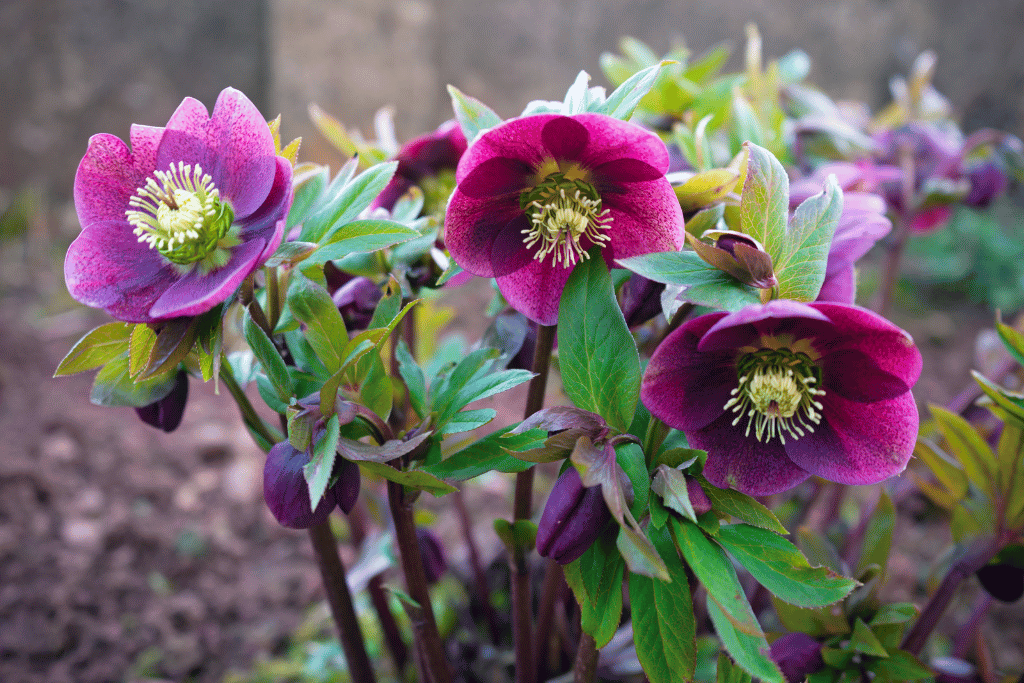
Hellebores, also known as Lenten Roses, bring a delicate touch of elegance to the winter landscape. Despite the cold temperatures, these hardy perennials start to bloom as early as late winter, showcasing their unique beauty when most other plants are dormant.
Originating from Europe and Asia, Hellebores display downward-facing, cup-shaped flowers that come in various shades, including white, pink, purple, and green. Their evergreen foliage adds a touch of greenery to the winter garden, making them a cherished sight during the colder months.
These resilient flowers thrive in shaded areas with well-draining soil. Their ability to bloom during the colder months makes them a valuable addition to gardens, providing a glimpse of nature’s beauty even in the midst of winter.
2. Hyacinth – Fragrant Harbingers of Spring

Hyacinths are fragrant spring flowers that herald the arrival of the warmer seasons. Native to the Mediterranean region, these bell-shaped blooms are known for their captivating scent and vibrant colors, ranging from deep blues and purples to pinks, whites, and yellows. Hyacinths are commonly associated with springtime and are often used in gardens, borders, and containers. Their strong fragrance makes them a popular choice for perfumes and scented products.
To grow healthy hyacinths, plant their bulbs in the fall in well-draining soil and provide them with ample sunlight. Their dense clusters of flowers create a visually stunning display and fill the air with their delightful fragrance, marking the end of winter’s chill.
3. Hibiscus – Exotic Blooms of Summer

Native to warm and tropical regions, hibiscus thrive in sunny environments and require ample water to flourish. Their trumpet-shaped flowers and glossy leaves create a lush and vibrant appearance in gardens and landscapes. Hibiscus flowers bring a tropical flair to the summer garden with their large, showy blooms and vibrant colors. These exotic-looking flowers come in various hues, including shades of red, pink, orange, yellow, and white.
Apart from their aesthetic appeal, some hibiscus species are also used for herbal teas and infusions. These striking flowers attract attention not only from humans but also from hummingbirds and butterflies, adding life and movement to outdoor spaces.
4. Heather – A Carpet of Blooms
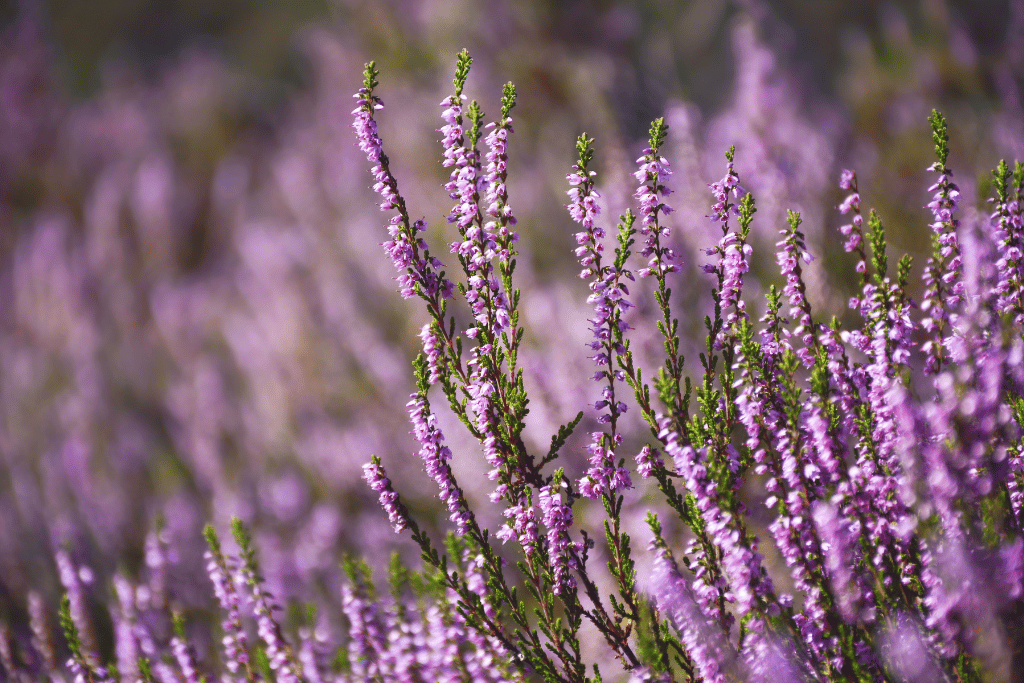
Heather, also known as Calluna vulgaris, is a low-growing shrub that covers landscapes with a carpet of small, colorful blooms. Native to Europe and parts of Asia, heather is celebrated for its ability to thrive in poor soils and harsh conditions.
Heather flowers come in various shades, including purple, pink, white, and red. They often bloom from late summer through fall, adding a burst of color to the fading landscape. These hardy plants are well-suited for rock gardens, slopes, and areas where other plants struggle to grow. Heather’s resilience and charming appearance make it a symbol of endurance and beauty in the face of adversity.
5. Heliotrope – Aromatic Beauty of the Sunset

Heliotrope, commonly referred to as the Cherry Pie Plant, captivates with its delightful aroma and gatherings of small, intricate blooms. Originating from Peru, this flower derives its name from its inclination to follow the sun’s path and orient itself towards it during the course of the day. The flowers of the heliotrope exhibit hues spanning from purple and blue to white, reminiscent of tiny arrangements of flowers. Their alluring fragrance, reminiscent of vanilla, has granted them a unique position in the realm of perfumes and scented goods.
These compact, bushy plants thrive in well-draining soil and plenty of sunlight. Often used in containers or borders, heliotropes bring a touch of elegance to gardens and patios. Their alluring fragrance and charming appearance make them a favorite among gardeners seeking both visual and olfactory delights.
6. Hollyhock – Towering Elegance of Cottage Gardens

Hollyhocks are available in a wide range of colors, including pink, white, yellow, and deep maroon, hollyhocks often reach impressive heights, providing vertical interest and structure to landscapes. These are iconic cottage garden plants known for their tall stalks adorned with vibrant, cup-shaped flowers. Native to Asia and Europe, these stately blooms create a sense of nostalgia and charm in gardens.
To cultivate healthy hollyhocks, provide them with well-draining soil and ample sunlight. These biennial or short-lived perennial plants often self-seed, creating a continuous display of flowers in the garden.
The towering elegance of hollyhocks adds a touch of old-world charm to modern landscapes. With their graceful presence and cottage garden vibes, they evoke a sense of romance and beauty reminiscent of bygone eras.
7. Hydrangea – Shapeshifting Blooms of Abundance

Cherished for their ability to change form, hydrangeas are renowned for their blossoms that undergo a remarkable shift in color based on the acidity of the soil they inhabit. This natural transformation results in a captivating spectrum of hues, ranging from serene blues and purples to delicate pinks and whites. The ever-changing beauty of hydrangeas offers an enchanting experience in the garden, capturing the imagination of both gardeners and admirers with their captivating hues.
Adaptable and flexible, these flowers flourish under varying levels of light, rendering them suitable for a diverse range of garden aesthetics. With their generously sized flower clusters, which often take on a fluffy appearance, hydrangeas make a striking focal point in gardens as well as in floral displays. Beyond their visual appeal, hydrangeas hold cultural significance and are often associated with heartfelt emotions. They are commonly used in wedding decor and represent gratitude, grace, and heartfelt emotions.
8. Honeysuckle – Fragrant Trails of the Wild

Honeysuckle vines are renowned for their sweetly scented, tubular flowers that attract hummingbirds and butterflies. These adaptable vines flourish in different soil types and light conditions, making them a versatile choice for gardens, arbors, and trellises. Their rapid growth and twining nature create a sense of movement and vitality in outdoor spaces.
Native to North America, Europe, and Asia, these vigorous climbers add a touch of wild beauty to landscapes. These charming flowers come in various shades, including white, yellow, orange, and pink, and they often emit a heady fragrance in the evenings, perfuming the air with their alluring scent. Honeysuckle’s ability to weave its way through the landscape and its enticing scent make it a captivating choice for those who appreciate the untamed elegance of nature.
9. Hyssop – Aromatic Herbs for Pollinators
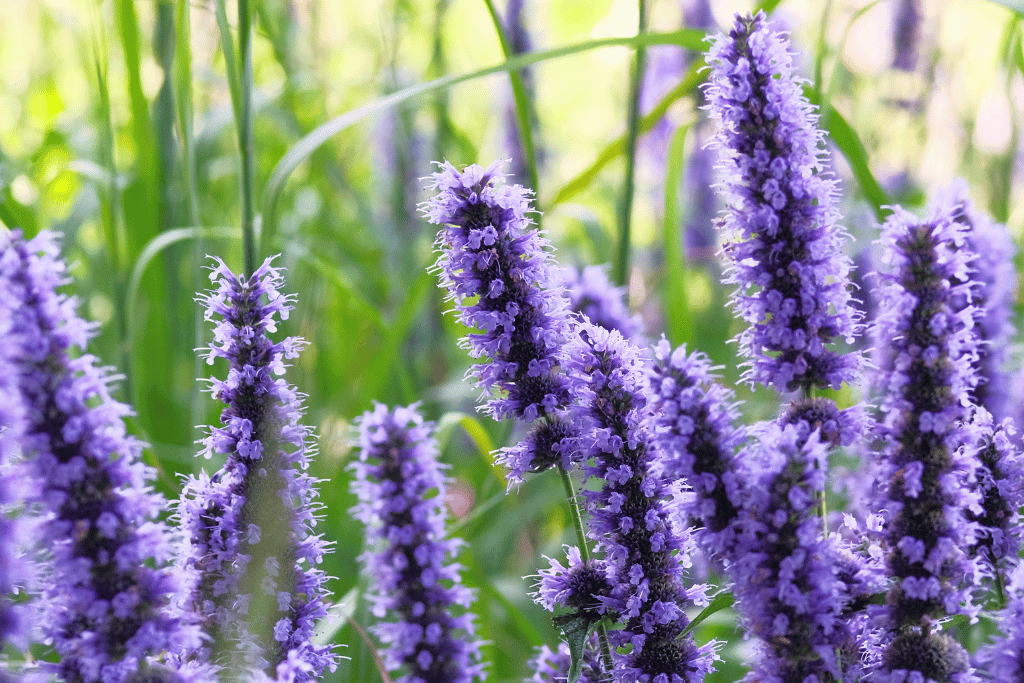
The flowers of hyssop come in shades of blue, purple, pink, and white, forming dense clusters that attract bees, butterflies, and other pollinators. The plant’s aromatic leaves and flowers are also used to make herbal teas and flavor dishes. In addition to its beauty and flavor, hyssop has been historically used for its medicinal properties. It has been associated with various health benefits, including respiratory support and relaxation.
Hyssop is a fragrant herbaceous plant that produces spikes of small, colorful flowers. Native to the Mediterranean region, hyssop is valued for both its ornamental and culinary uses. With its visual appeal and ecological contributions, hyssop adds a delightful touch to herb gardens and mixed borders, providing not only beauty but also sustenance for pollinating insects.
10. Hosta – Leafy Elegance in Shade Gardens

Hostas are renowned for their lush, leafy foliage that brings elegance to shady gardens. Originating from East Asia, these perennial plants are cherished for their wide array of leaf shapes, sizes, and hues. These pretty queens thrive in shaded or partially shaded areas with well-draining soil. Their low-maintenance nature and adaptability make them popular choices for landscaping, particularly in areas with limited sunlight.
While hostas are not primarily grown for their flowers, they do produce tall spikes adorned with small, bell-shaped blooms in shades of white or lavender. However, it’s the vibrant foliage that steals the spotlight, ranging from deep greens to variegated patterns.
With a wide variety of cultivars available, hostas offer endless possibilities for creating texture and interest in shade gardens, enhancing the overall aesthetic appeal of outdoor spaces.
11. Helenium – Autumnal Splendor in the Garden

Helenium, also known as Sneezeweed, is a late-summer and autumn bloomer that adds a burst of color to gardens as the seasons change. Native to North and Central America, helenium flowers are known for their daisy-like appearance and warm, rich hues. These cheerful blooms come in shades of red, orange, yellow, and bronze, often with distinctive brown centers. Their ability to thrive in wetter conditions makes them valuable for rain gardens or areas with moist soil.
Helenium’s vibrant colors and unique form attract pollinators like bees and butterflies, contributing to the garden’s ecological balance. As other flowers fade, heleniums offer a final flourish of color before the arrival of winter.With their rustic charm and autumnal splendor, heleniums provide a fitting farewell to the growing season, inviting observers to appreciate the beauty of nature’s transitions.
12. Hesperis – Fragrant Delights of the Evening
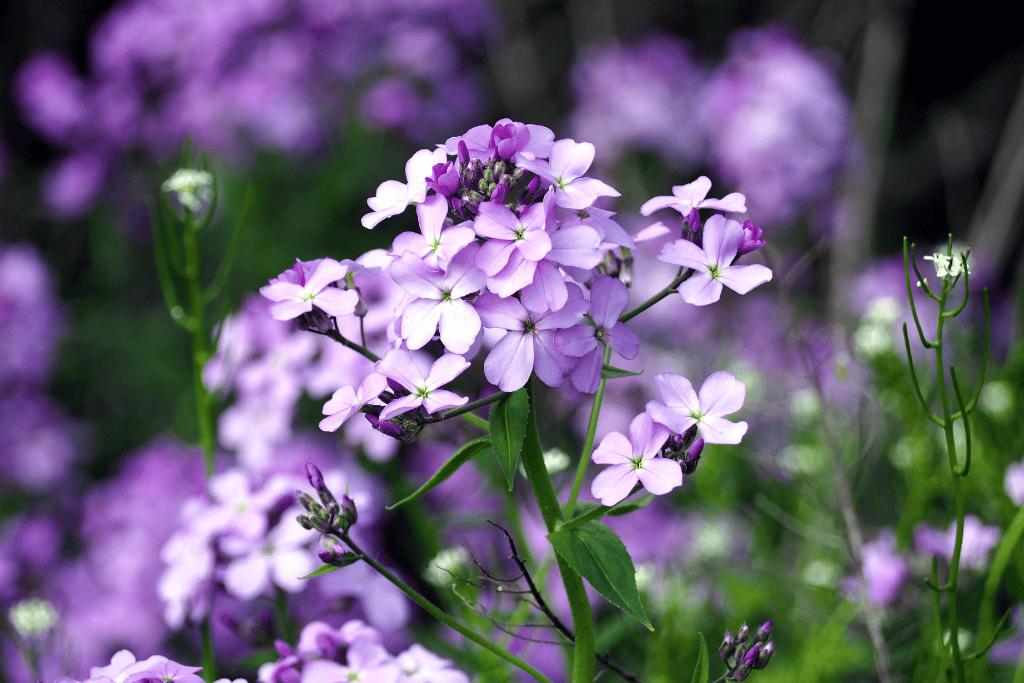
In gardens where its growth is managed, Hesperis adds a touch of old-world charm and fragrant enchantment, making evening strolls through the garden a truly delightful experience. Originating from Europe and Asia, these flowers are frequently encountered in cottage gardens and lining the edges of roads. Hesperis, commonly known as Sweet Rocket or Dame’s Rocket, is a flowering plant celebrated for its delightful fragrance and charming blooms.
Despite its beauty and fragrance, Hesperis can be invasive in some regions, spreading quickly and outcompeting native plants. It’s important to be mindful of its potential impact on local ecosystems. The flowers of Hesperis come in shades of pink, purple, and white, forming clusters that emit a sweet and alluring scent, especially in the evening. Their scent attracts moths and other nighttime pollinators.
13. Hibbertia – Radiant Blooms of Australia
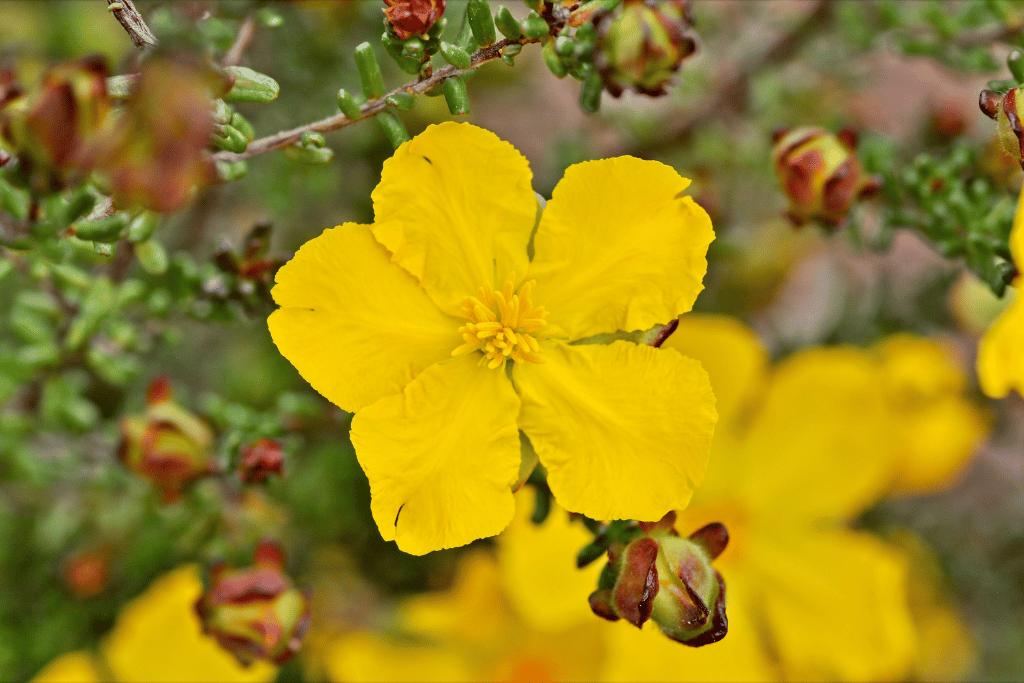
Hibbertia is a genus of flowering plants native to Australia, renowned for their radiant blooms and ability to thrive in various climates. These evergreen shrubs and vines are cherished for their contribution to landscapes and gardens. The flowers of Hibbertia come in shades of yellow, often resembling cheerful, sunny faces. Their vibrant color and unique appearance make them stand out in garden beds and containers.
Hibbertias are adapted to different soil types and are well-suited for coastal environments due to their salt tolerance. Their versatility and resilience make them valuable additions to gardens, particularly those seeking to incorporate native and drought-tolerant plants.
In Australia, Hibbertias have cultural significance as well, with some species being used in traditional medicine and indigenous practices. Their beauty and connection to the land make them an integral part of the country’s flora.
14. Houstonia – Tiny Gems of Woodland Beauty
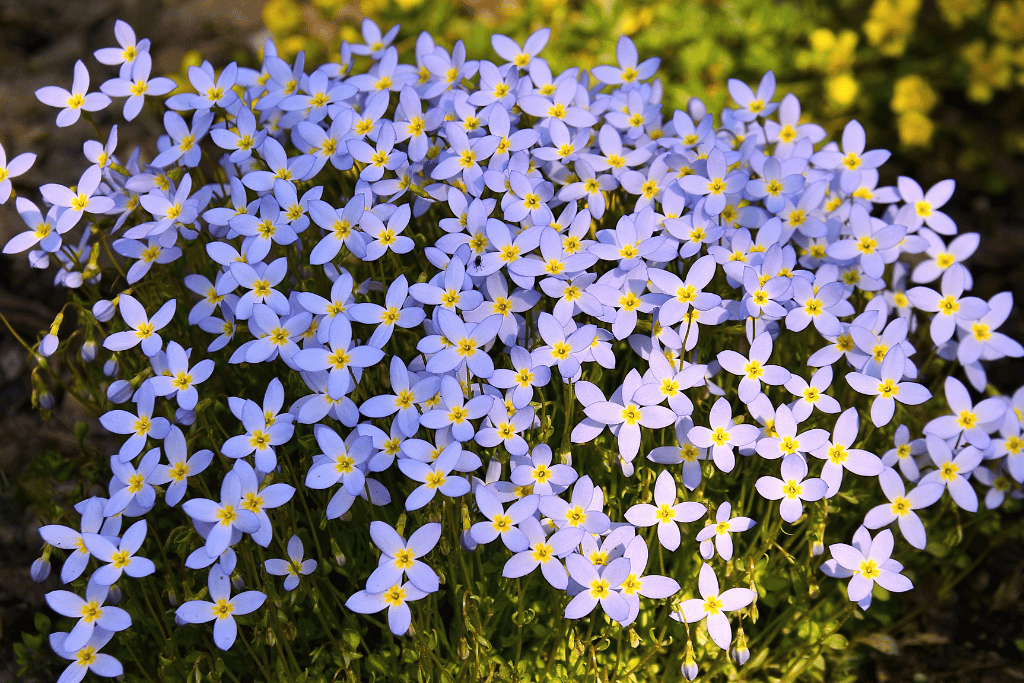
Houstonias are a favorite among wildflower enthusiasts and those who appreciate the intricate beauty of native plants. Their unassuming elegance and ability to thrive in natural habitats contribute to the biodiversity of local ecosystems. These purple beauties, also known as Bluets or Quaker Ladies, are tiny, delicate wildflowers that grace woodlands and meadows with their charming presence. Native to North America, Houstonia flowers are beloved for their simplicity and dainty blossoms.
The flowers of Houstonia are typically blue, although white and pink varieties can also be found. They have a unique structure with four petals and a bright yellow center, resembling miniature stars. These wildflowers thrive in partial shade to full sunlight, making them ideal for naturalized areas and woodland gardens. Their low-growing habit and early blooming season often coincide with the emergence of spring ephemerals.
15. Hymenocallis – Elegance of Spider Lilies
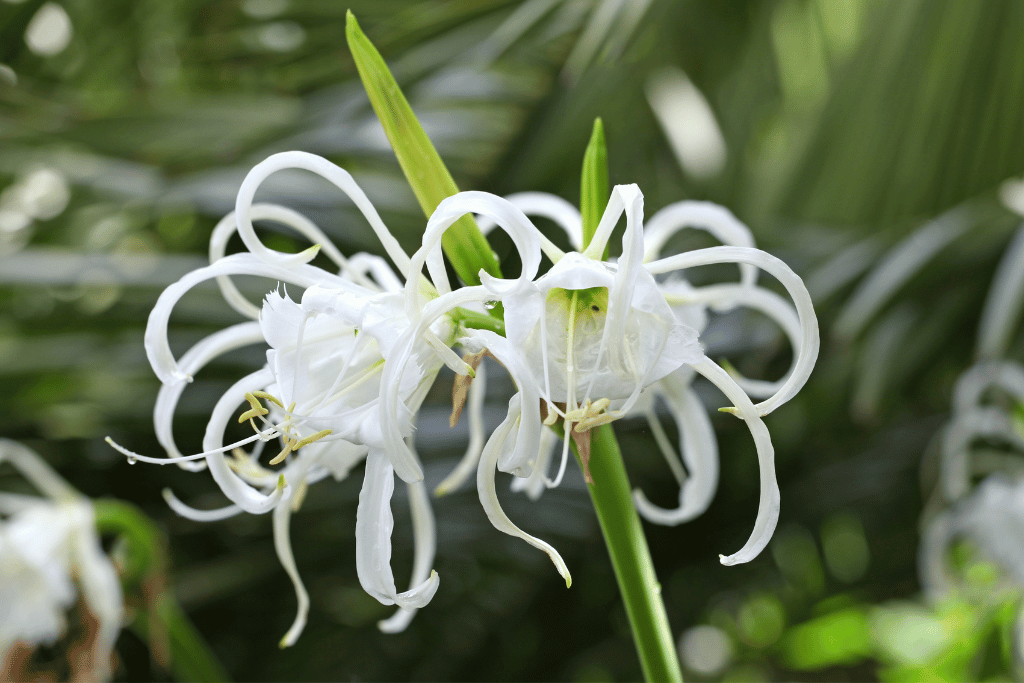
The unique allure of Spider Lilies adds a touch of mystery and grace to gardens, inviting observers to appreciate the intricate artistry of nature. Native to the Americas, these flowering bulbs are cherished for their striking appearance. Hymenocallis, commonly known as Spider Lilies, captivate with their exquisite, intricate flowers and elegant presence. The flowers of Hymenocallis are characterized by their elongated, spidery petals that radiate from a central hub. They come in shades of white, often with intricate markings or contrasting centers.
Spider Lilies thrive in moist or wet soil and are often found near water bodies or in damp woodlands. Their distinctive beauty and adaptability have led to their cultivation in gardens and landscapes. Apart from their ornamental value, Hymenocallis have cultural significance as well. They are used in various traditional practices and ceremonies, representing purity, elegance, and the cycle of life.
16. Hemerocallis – Daylilies: Nature’s Colorful Palette

The flowers of Hemerocallis come in a wide spectrum of colors, including red, orange, yellow, pink, and even bi-color combinations. Each bloom lasts only a day, but the plants produce numerous buds, resulting in a continuous display of beauty. Hemerocallis, commonly known as Daylilies, are vibrant and prolific flowering perennials. Native to Asia, these resilient plants have become popular worldwide due to their stunning range of colors and extended blooming periods.
With their diverse colors and reliable blooms, Daylilies offer a dynamic and ever-changing garden scene. Their presence adds vibrancy and life to outdoor spaces, reminding us of nature’s endless capacity for creativity. Daylilies are adaptable and thrive in various soil types and light conditions. Their versatility and easy care make them a staple in gardens, borders, and landscaping projects.
17. Heliopsis – Sunflowers of the Prairie
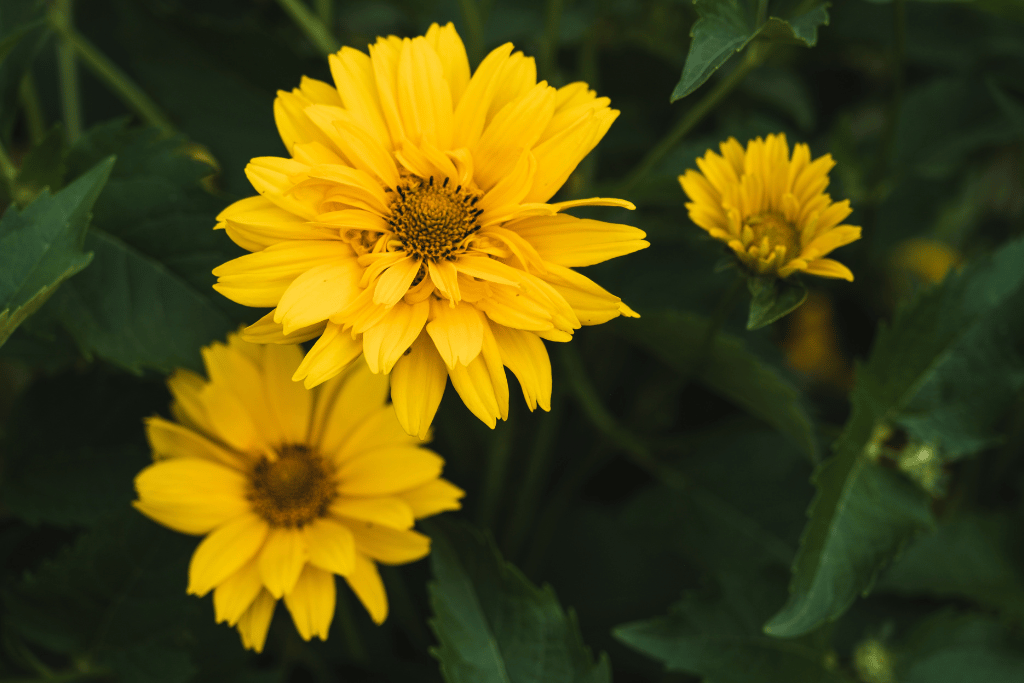
The flowers of Heliopsis are daisy-like, with bright yellow or orange petals and a contrasting center. Their resemblance to sunflowers adds a sense of familiarity and warmth to outdoor spaces. Commonly known as False Sunflowers, they are cheerful and robust perennials native to North America. Resembling their close cousins, sunflowers, Heliopsis bring a touch of sunshine to gardens and meadows.
False Sunflowers thrive in sunny locations with well-draining soil. Their tolerance for different soil types and drought conditions make them a reliable choice for low-maintenance landscapes. Heliopsis are not only attractive to humans but also draw in pollinators like bees and butterflies. Their nectar-rich flowers contribute to the ecological health of gardens and provide a feast for beneficial insects.
18. Holmskioldia – Chinese Hat Plant’s Exotic Charisma

Beyond their visual appeal, the unique structure of Holmskioldia flowers attracts hummingbirds and other nectar-seeking creatures. Their charismatic charm and exotic allure make them a captivating addition to tropical and subtropical landscapes. The flowers of Holmskioldia are tubular and resemble a Chinese hat or cup and saucer, with a brightly colored “hat” surrounded by a contrasting “saucer.” They come in shades of orange, red, yellow, and pink.
Holmskioldia, also known as Chinese Hat Plant or Cup-and-Saucer Plant, is an exotic shrub admired for its unique and intricate flowers. Native to Asia, this plant’s distinctive blooms add a touch of the exotic to gardens and tropical landscapes. Chinese Hat Plants thrive in warm and humid climates with well-draining soil. Their showy flowers and lush foliage create a lush and vibrant appearance in gardens and containers.
19. Helianthemum – Sun-Kissed Beauty of Rock Gardens

The flowers of Helianthemum come in a variety of colors, including shades of yellow, orange, pink, and white. Their delicate petals open up in the sun, creating a cheerful display that resembles a miniature sunrise. Helianthemum, commonly known as Sun Rose or Rock Rose, is a sun-loving perennial that graces rock gardens and dry slopes with its vibrant beauty.Their presence adds a touch of wild beauty to landscapes, reminding us of the diverse treasures nature offers.
Sun Roses thrive in well-draining soil and require full sunlight to flourish. Their low-growing habit and ability to thrive in arid conditions make them ideal for rock gardens and xeriscaping. Native to Europe and North America, these flowers are cherished for their resilience and charm.
Aside from their ornamental value, some species of Helianthemum are known for their medicinal properties and traditional uses.
20. Hoya – Exquisite Beauty of Wax Flowers
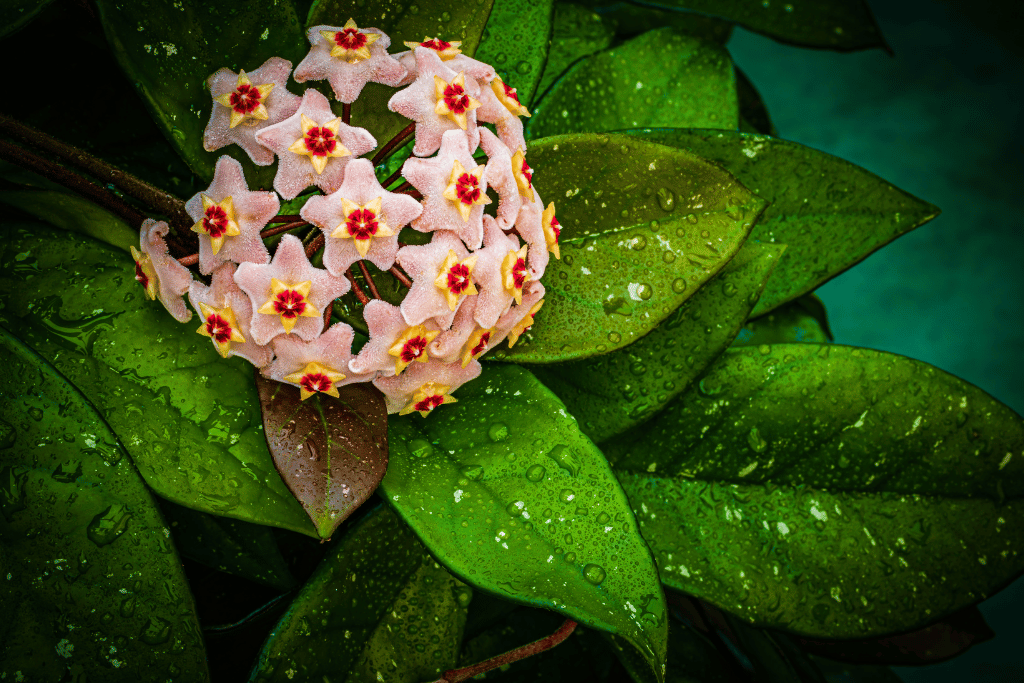
The flowers of Hoya come in various shapes and colors, with some resembling stars or clusters of wax-like blossoms. Their thick, waxy texture adds to their charm and gives them their common name. Commonly they are called Hoya Wax Plant or Porcelain Flower, a group of tropical vines treasured for their unique waxy flowers and glossy foliage. Native to Asia and Australia, Hoyas are often cultivated as houseplants and are admired for their intricate blooms.
Wax Plants thrive in bright indirect light and well-draining soil. They are often grown in hanging baskets or allowed to trail along trellises, adding a touch of elegance to indoor spaces. Hoyas are not only visually appealing but also known for their air-purifying qualities. Their exotic beauty and easy care make them popular choices for plant enthusiasts seeking something extraordinary.
21. Hylocereus – Night-Blooming Wonders of the Desert

Hylocereus, often recognized as Night-Blooming Cereus or Dragon Fruit Cactus, comprises a collection of cacti renowned for their captivating blooms that unfurl during the night, along with their distinctive fruit. Originating from Central America and various regions in Asia, these desert plants contribute an element of enigma to their surroundings. Hylocereus thrives in sunny and dry conditions, making it well-suited for desert gardens and xeriscaping. Its ability to bloom at night adds an element of surprise and wonder to the garden, captivating those who venture out after dark.
The blossoms of Hylocereus are sizeable and striking, with a tendency to unfurl during the nighttime and shut as morning arrives. They exhibit hues spanning from white and cream to pink, and their intricate configuration enhances their charm
Night-Blooming Cereus are typically grown for their ornamental value and their unusual fruit, known as dragon fruit. The fruit’s vibrant colors and unique appearance make it a favorite among health-conscious consumers.
22. Hamelia – Firebush: Nature’s Flamboyant Palette
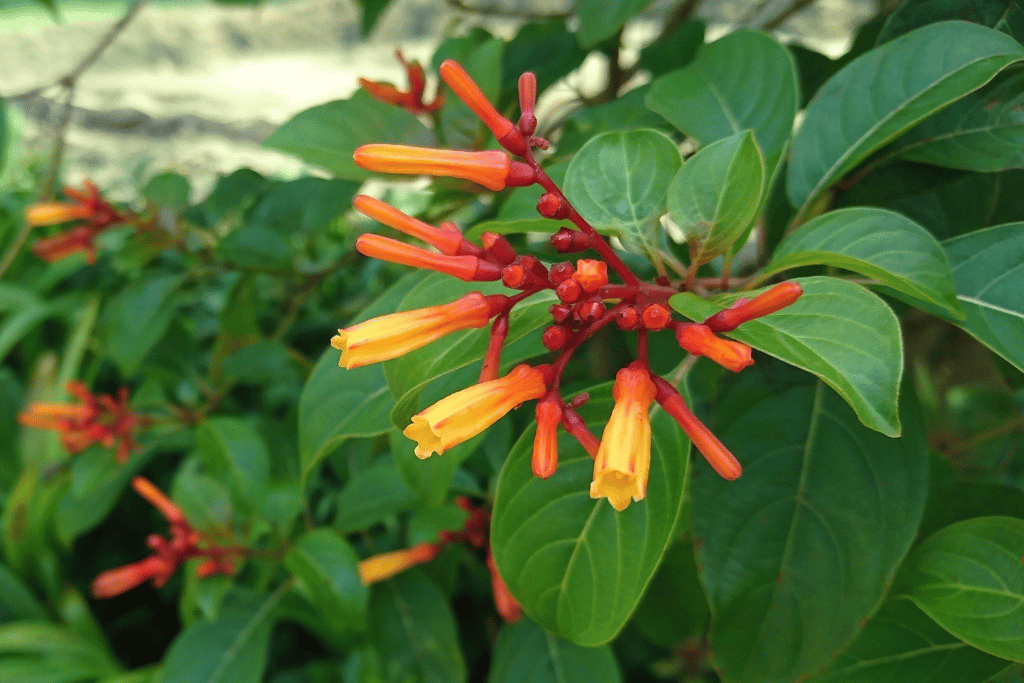
Hamelia thrives in warm and sunny climates, often reaching a height of several feet. Its lush foliage and bright flowers create a striking contrast against the backdrop of greenery. Native to the Americas, these vibrant flowers light up gardens with their fiery hues.
The flowers of Hamelia come in shades of red, orange, and yellow, resembling flickering flames. Their tubular shape and nectar-rich blooms make them a favorite among hummingbirds and butterflies. Hamelia, commonly known as Firebush or Hummingbird Bush, is a tropical shrub celebrated for its vividly colored blooms and its ability to attract hummingbirds and other pollinators. In addition to its ornamental value, Hamelia has traditional uses in herbal medicine and indigenous practices. Its bold and captivating presence adds a touch of tropical splendor to outdoor spaces.
23. Hygrophila – Aquatic Beauty for Water Gardens
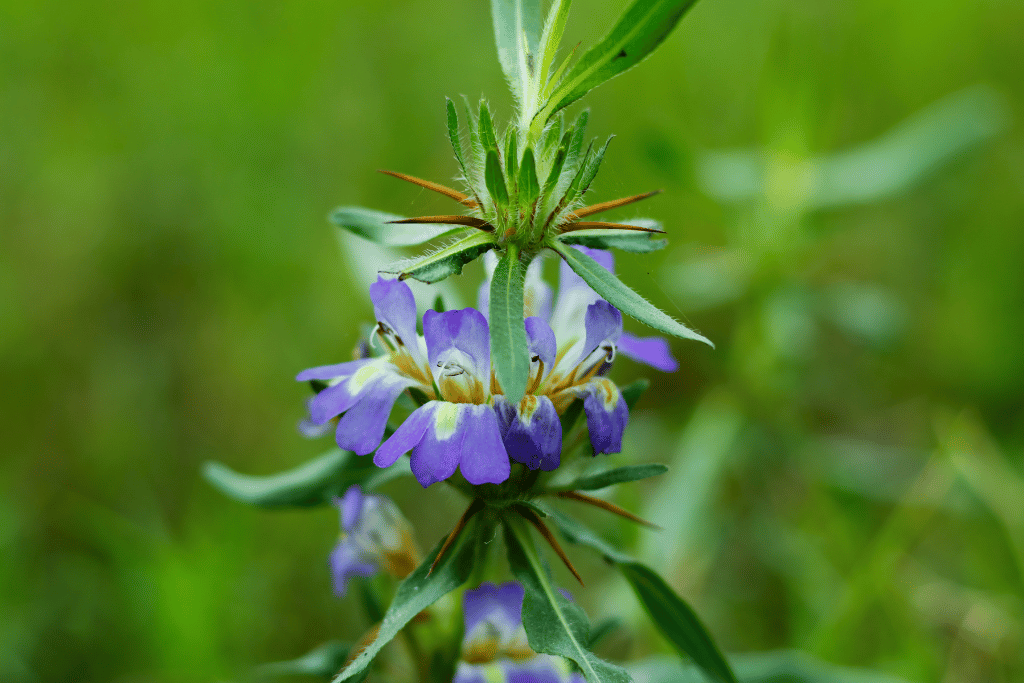
In addition to their ornamental value, Hygrophila plants contribute to water quality by absorbing excess nutrients and providing shelter for aquatic organisms. Their presence adds life and vibrancy to underwater landscapes, reminding us of the beauty that thrives beneath the surface. Hygrophila, commonly known as Hygro, is a genus of aquatic plants that thrive in water gardens and aquariums.
Indigenous to Asia, these adaptable plants are appreciated for their lively look and capacity to elevate aquatic surroundings.The flowers of Hygrophila are often small and inconspicuous, but it’s their lush and colorful foliage that makes them popular among aquarists and water garden enthusiasts.
Hygrophila species vary in growth habit, with some being submerged aquatic plants and others growing partially or fully above the water’s surface. This diversity allows for creative landscaping and designing aquatic habitats.
24. Hamamelis – Witch Hazel: Winter’s Blooming Enigma

Hamamelis, commonly known as Witch Hazel, is a deciduous shrub renowned for its unique late-winter blooms that defy the cold season. The flowers of Hamamelis are spidery and fragrant, with strap-like petals that unfurl even when snow is on the ground. They come in shades of yellow, orange, and red, creating a warm contrast against the winter backdrop. Witch Hazel’s ability to bloom during the dormant months has led to its association with healing and renewal. Its extract is also used in various skincare products due to its soothing properties.
Despite its common name, Witch Hazel’s enchanting blooms are anything but wicked. They offer a ray of hope and beauty during the colder months, reminding us of nature’s capacity to surprise and inspire. Native to North America and Asia, Witch Hazel’s delicate flowers bring a touch of magic to winter landscapes.




Pingback: Flower That Starts With Dip - Back Gardener